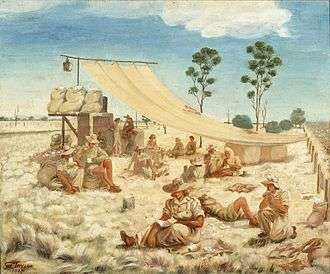Australian Women's Land Army


The Australian Women's Land Army (AWLA) was an organisation created in World War II in Australia to combat rising labour shortages in the farming sector. The AWLA organised female workers to be employed by farmers to replace male workers who had joined the armed forces.
History
The AWLA was formed on 27 July 1942 and was modelled on Women's Land Army in Great Britain. When Japan joined the Axis in 1941 male agricultural labour was recruited into the Australian military to defend the country. To meet the shortfall in rural labour, state and private women’s land organisations began to form under the jurisdiction of the Director General of Manpower. The AWLA disbanded on 31 December 1945. In 1997, many members became eligible for the Civilian Service Medal.
The minimum age for recruits was 18 with a maximum of 50 years of age. Women had to be either be of British origin or immigrants from Allied nations. AWLA women were generally recruited from urban areas and were often unskilled in rural work. Members were given farming instruction and undertook work in primary industries, rather than any domestic duties at the hostels in which they were lodged in farming areas.[1] The AWLA reached its peak enrolment in December 1943, with 2,382 permanent members and 1,039 auxiliary members. Women in the AWLA worked an average 48-hour week, with pay starting at the AWLA minimum wage of 30 shillings a week. Permanent members were also entitled to sick pay. As was common at the time, Women in the AWLA were paid much less than their male counterparts for the same work. Members of the AWLA covered a variety of agricultural labours, including vegetable and fruit growing, pig and poultry raising, and sheep and wool work.
The AWLA was planned to function in two divisions:
- Full-time members: These enrolled for continuous service for 12 months (with the option of renewal); such members were to receive appropriate badges, distinctive dress uniform, working clothes, and equipment.
- Auxiliary members: These were available for periods of not less than four weeks at nominated times of the year; such members were to be used for seasonal rural operations, and to receive a badge, working clothes, and essential equipment on loan.

To celebrate the 70th anniversary of the formation, the Australian Government agreed to a range of measures to recognise and thank the ‘land army girls’ for their commitment and efforts. A reception was held in Parliament House on Monday 20 August 2012 which acknowledged those surviving former AWLA members who were able to attend. Attendees were presented with a commemorative certificate, a commemorative brooch and a copy of a commemorative history publication of the AWLA.
For many years after the war little if any acknowledgement was given to the service provided by the AWLA. Mrs Peggy Williams OAM, a former member of the AWLA led the campaign for proper recognition of all 'land army girls' efforts during the war years. This was acknowledged in a speech given by the Prime Minister of Australia at the Parliament House reception marking the 70th anniversary.
See also
- Women's Auxiliary Australian Air Force
- Women's Royal Australian Naval Service
- Female roles in the World Wars
- Australian Women's Army Service
- British Women's Land Army
- Woman's Land Army of America
- Victory garden
- Australian home front during World War II
- Women of war recognised, Senator John Faulkner
References
- ↑ "The Australian Women's Register". Australian Women's Archive Project. 29 November 2002. Retrieved 17 April 2015.
External links
- Australian Government: Women in Wartime
- Victoria: Women's Land Army
- Women's History Forum
- Australian War Memorial